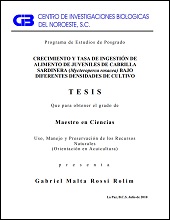Crecimiento y tasa de Ingestión de Alimento de Juveniles de Cabrilla Sardinera (Mycteroperca rosacea) bajo Diferentes Densidades de Cultivo
Resumen
Se estudio el efecto de la densidad sobre el crecimiento, tasa de ingestión de alimento y coeficiente de variación en juveniles de cabrilla sardinera, Mycteroperca rosacea. Las densidades probadas fueron 77, 154 y 230 peces.m-3 con tres réplicas cada una. Los juveniles (peso inicial 24.8 ±2.56g) fueron cultivados en nueve jaulas de 65 litros confinadas en un tanque circular de 7m3. La temperatura y la salinidad se mantuvieron entre 23.1-26.4°C y 38-39ups, respectivamente. El oxígeno se mantuvo arriba de 5.33 mg.L-1. La alimentación fue suministrada ad libitum cuatro veces al día (8:00, 10:30, 13:00 y 15:30h) y se registró la cantidad de alimento suministrado y no consumido. Se utilizó alimento microparticulado Bernaqua® de 1.5mm con 50% proteína y 14% grasa neta. Se realizaron biometrías al inicio del experimento, al día 29 y 61 de cultivo, en las cuales se registró la longitud total en centímetros y el peso en gramos de todos organismos de cada jaula. Se determinó diferencias en el crecimiento, tasa de ingestión de alimento, factor de conversión alimenticia y coeficiente de variación. El mejor desempeño (peso final, longitud total final, tasa de crecimiento absoluta y específica, factor de conversión alimenticia y eficiencia alimenticia) fue obtenido en el grupo de menor densidad (77 peces.m-3). Se observó un aumento en la tasa de ingestión de alimento con el tiempo y una relación directa con la densidad de cultivo, en donde el grupo sembrado a mayor densidad presentó los mayores valores de ingesta de alimento. La supervivencia no se vio afectada por las densidades probadas, así como el coeficiente de variación, que aumentó con el tiempo de cultivo en todos los grupos. The effect of stocking density on growth, food intake rate and growth variation of the juvenile leopard grouper Mycteroperca rosacea was tested for over 61 days. The stocking densities tested were 77, 154 y 230 fish.m-3.The juveniles (initial weight 24.8 ±2.56g) were raised in nine 65 liters PVC-cages with three cages each stocking density. Because water quality affect growth rate, differences in water quality were minimized by placing the nine cages into the same 7m3 tank. During experimental period dissolved oxygen, salinity and temperature were 5-6 mg.L-1, 38-39ppt and 23.1-26.4°C respectively. Fish were fed to satiation four times a day (8:00, 10:30, 13:00 y 15:30h) with a commercial feed. Feed composition according producer was as follows: 1.5mm, crude protein 50%, crude fat 14%, crude fiber 0.5%, and crude ash 10%. All fish were measured and weighed at day 29 and 61. Survival, final weight, total length, absolute growth rate, specific growth rate, feed conversion rate, food intake rate, feed efficiency and coefficient of variation for each cage were calculated. To determine the effects of stocking density on growth, food conversion rate, coefficient of variation, food intake rate and feed efficiency an analysis of variance was used. The best performance (final weight, final total length, absolute growth rate, specific growth rate, food conversion rate and feed efficiency) were obtained by the lowest density group (77 fish.m-3). The food intake rate where higher in the highest density group (230 fish.m-3) and showed a positive correlation with stocking density. Survival was not affected by the densities tested. The coefficient of variation increased with culture time in all groups.
Colecciones
Ítems relacionados
Mostrando ítems relacionados por Título, autor o materia.
-
PROMOCIÓN DEL PERIFITON PARA EL CULTIVO DE CAMARÓN BLANCO: HACIA UNA ACUICULTURA ECOLÓGICA
DOMENICO VOLTOLINA LOBINA; JUAN MANUEL AUDELO NARANJO; MARIA DEL ROSARIO PACHECO MARGES -
Suelo y Erosión
YOLANDA LOURDES MAYA DELGADO


